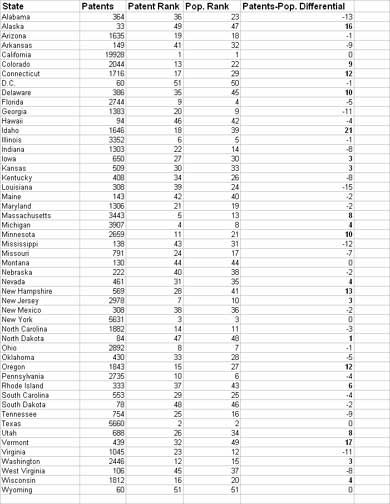Idaho first, La. last in patent-population ratio


The U.S. Patent & Trademark Office is out with their list of Patents issued to residents of the United States. Many of these patents are for communications innovations that find their way into broadband and telephony applications.
Last night, I went to Page 125 in the USPTO's Annual Report, which lists patents awarded by state. Then, I worked up an Excel sheet of those states, by ranked order of patents awarded. I then compared that list to the latest U.S. Census estimates of state population in ranked order.
No surprise that the top three states in population- California, Texas, and New York- ranked in the top three of patents awarded. But then, as I went thru the list, I found that some state's patent award ranking significantly outstripped their population rank. Often, that's a result of research-heavy government labs, corporations, and major universities.
Conversely, several states rank significantly higher in population than they do in patents awarded. A case could be made that those states could use more corporate, governmental and academic research infrastructure.
Here are the states with a +10 or greater patent to population rank for 2005:
Idaho 21
Vermont 17
Alaska 16
New Hampshire 13
Connecticut 12
Oregon 12
Delaware 10
Minnesota 10
Now, let's look at the states with a -10 or worse differential between their population ranking and their patent ranking:
Georgia -11
Virginia -11
Mississippi -12
Alabama -13
Louisiana -15
Interesting that the five states that seem to be trailing in patent innovativeness are all southern states. I would hope that education and industry leaders in those states take this as an indicator that more investment is needed in technology development infrastructure.